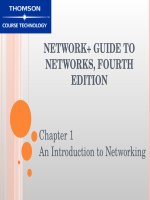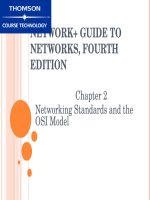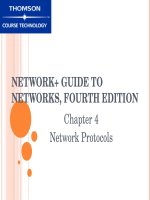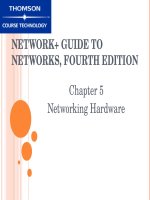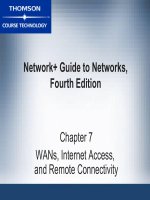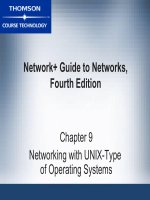Guide to network essentials 4th chapter 02
Bạn đang xem bản rút gọn của tài liệu. Xem và tải ngay bản đầy đủ của tài liệu tại đây (1.45 MB, 44 trang )
Chapter 2:
Network Design Essentials
Learning Objectives
Design a network layout
Understand the various networking topologies
Integrate the use of hubs into your networks
Integrate the use of switches into your network
Explore the variations of the standard networking
topologies
Select the best network topology for your environment
Construct your network layout
Guide to Networking Essent
2
Network Design
Good network design includes:
Analyzing
network requirements
Selecting a network topology
Selecting equipment to fit that topology
Guide to Networking Essent
3
Designing a Network Layout
Topology refers to physical layout including
computers, cables, and other resources
Determines
how components communicate with each
other
Basic network design can be described by the
terms topology, layout, diagram, and map
Guide to Networking Essent
4
Designing a Network Layout
(continued)
Physical topology refers to arrangement of
cabling
Logical topology refers to how data travels
between computers on the network
Network may use one physical topology but a
different logical topology to pass data
Guide to Networking Essent
5
Designing a Network Layout
(continued)
Topology affects network’s performance and
growth potential
Topology determines type of equipment to
purchase and how to manage network
Consider growth and security requirements
Good design grows and adapts as needs
change
Guide to Networking Essent
6
Standard Topologies
Today’s network designs are based on three
topologies:
Bus
consists of series of computers connected along
a single cable segment
Star connects computers via central connection point
or hub
Ring connects computers to form a loop
Guide to Networking Essent
7
Bus
Simplest topology
Components connect via backbone or single
cable segment
See Figure 2-1
Major weakness is single cable break can
halt entire network
Guide to Networking Essent
8
Bus Topology Network
Guide to Networking Essent
9
Sending the Signal
All computers, regardless of topology,
communicate by addressing data to one or more
computers and transmitting it across cable as
electronic signals
Data
is broken into packets and sent as electronic
signals that travel on the cable
Only the computer to which the data is addressed
accepts it
Guide to Networking Essent
10
Bus Communications
In bus topology, only one computer can send
information at a time
Network
performance slows as more computers are
placed on the bus
Guide to Networking Essent
11
Bus Communications (continued)
Bus is a passive topology
Computers
only listen for data being sent; not responsible
for moving data to next computer
Failure of one computer has no effect on rest of network
In active topology, computers regenerate signals;
move data through network
Guide to Networking Essent
12
Signal Bounce
Signals move from point of transmission to both
ends of any bus
Something must stop signals when they reach
end of bus to avoid signal bounce
See
Figure 2-2
Terminator attached to end of cable absorbs
electronic signal prevents signals from bouncing
See
Figure 2-3
Guide to Networking Essent
13
Signal Bounce
Guide to Networking Essent
14
Terminated Bus Network
Guide to Networking Essent
15
Cable Failure
Cable break means bus network is no longer
terminated
Without termination, signals bounce and halt all
network activity
See Figure 2-4
Guide to Networking Essent
16
Cable Break
Guide to Networking Essent
17
Bus Network Expansion
Easy to expand bus network by using Ethernet 10Base2
(thinnet) and BNC barrel connectors
Longer network segments can cause attenuation or
weakening of signal
Repeater regenerates incoming signals to eliminate
signal attenuation
Does not correct incoming errors
Bus topology not so popular because a single cable
failure can bring down entire network plus difficult to
troubleshoot and manage
Guide to Networking Essent
18
Star Topology
Dominant topology in today’s networks
See
Figure 2-5
Connects computers to central hub that receives
and transmits signals to all devices
Only
computer to which packet is addressed processes it
Guide to Networking Essent
19
Star Topology (continued)
Offers centralization of resources, but requires
more cable and has single point of failure
If the hub fails, network is down, but failure of
single computer or cable does not affect
network
Easier to troubleshoot
Guide to Networking Essent
20
Star Network
Guide to Networking Essent
21
Ring Topology
Computers attached in a circle with no termination
necessary
Signals
travel in one direction around ring
Each computer receives signal and passes it along
See Figure 2-6
Electronic token passes around ring with computer
able to communicate only when it has token
May
be physically wired as a star with central
hub passing token in a circle
Guide to Networking Essent
22
Ring Network
Guide to Networking Essent
23
Ring Network
Some networks use dual counter-rotating
rings for speed and redundancy
Fiber
Distributed Data Interface (FDDI)
One computer failing can bring down single-ring
network unless it has smart hub that automatically
removes failed computer from ring
When one ring fails, dual ring network uses
secondary ring and continues to work
Shares network resources equally – all stations
are guaranteed a chance to send data
Guide to Networking Essent
24
Wireless Topologies
Eliminate cables
Simplest topology is peer-to-peer or ad-hoc in
which computers communicate directly with one
another
More common is to use centralized device
similar to hub to control communication, called
an access point (AP)
Star
topology
Signals travel through one central device
Guide to Networking Essent
25

